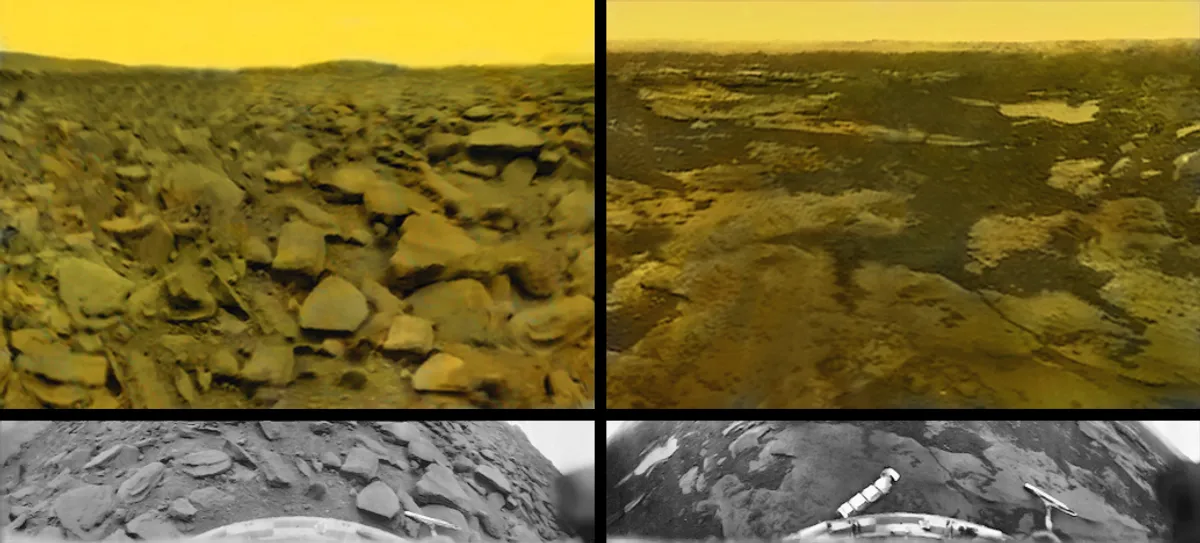The Soviet Union’s failed Kosmos 482 Venus spacecraft is set to make a somewhat delayed reappearance as it slams into the Earth in the next few days.
Between 1961 and 1984, the Soviet Union launched a series of space probes in order to study the second-closest planet to the Sun. The overall program was a resounding success, with Venera 3 becoming the first spacecraft to reach the surface of another planet on March 1, 1966. Not far behind it in August 1970, Venera 7 made the first soft landing on another world, and Venera 9 later transmitted the first ever images from the surface of a planet other than our own.
As well as this, the series of probes delivered the first audio from another world, and made high-resolution radar scans of the Morning Star. Side note, but it’s definitely worth checking out the only images ever taken of the surface of Venus.

The surface of Venus, captured by the Venera 9 and Venera 10 probes.
Image Credit: Russian Academy of Sciences, courtesy of Ted Stryk
Unfortunately, as is often the case with sending spacecraft flying into the Solar System, not all of the probes made it to their final destination. One probe, launched in 1972, failed to make it to its target, earning it the name Kosmos 482.
“Beginning in 1963, the name Cosmos was given to Soviet spacecraft which remained in Earth orbit,” NASA explains, “regardless of whether that was their intended final destination.”
The spacecraft, designed to withstand the thick atmosphere of Venus, hit trouble soon after launch.
“After achieving an Earth parking orbit, the spacecraft made an apparent attempt to launch into a Venus transfer trajectory,” NASA explains. “It separated into four pieces, two of which remained in low Earth orbit and decayed within 48 hours, and two pieces (presumably the payload and detached upper stage engine unit) went into a higher 210 x 9800 km orbit. It is thought that a malfunction resulted in an engine burn which did not achieve sufficient velocity for the Venus transfer and left the payload in this elliptical Earth orbit.”
The descent craft has been in this highly elliptical orbit around Earth ever since. Unfortunately, the spacecraft’s orbit has also decayed, bringing it closer to the planet. According to current predictions from satellite analyst Marco Langbroek, who has tracked the Kosmos 482 for years, the spacecraft will impact Earth on May 10, 2025, at 7:34 UTC, give or take around 15 hours.
While the object is small and by no means a threat to a large area, it will be an interesting re-entry, and not one you’d like to be around when it lands.
“As this is a lander that was designed to survive passage through the Venus atmosphere, it is possible that it will survive reentry through the Earth atmosphere intact, and impact intact,” Langbroek explains on the SatTrackCam Leiden blog.
“The risks involved are not particularly high, but not zero: with a mass of just under 500 kg and 1-meter size, risks are similar to that of a meteorite impact.”
“It likely will be a hard impact: I doubt the parachute deployment system will still work after 53 years and with dead batteries,” he added.
At present, the lander has an orbital inclination of 51.95 degrees, and could hit parts of Europe, Asia, the Americas, Australia, or Africa, though, given the vast amounts of ocean on our planet, a watery end is most likely.
Predictions may change as the spacecraft approaches. The craft has an assumed mass of 480 kilograms, but this isn’t certain, while space weather can also play a part in disrupting spacecraft orbits. Langbroek will provide updates as the aging Soviet spacecraft makes its approach to Earth.
Source Link: In 1972 The Soviets Launched A Spacecraft Bound For Venus. In The Next Few Days, It Will Return To Earth